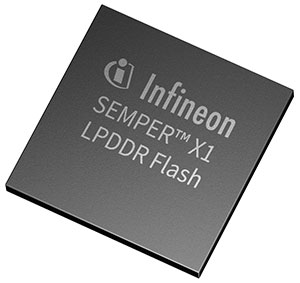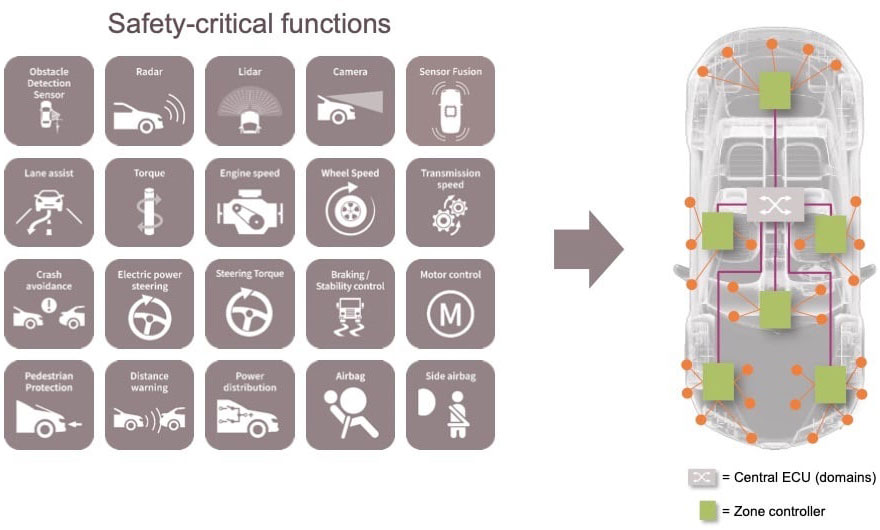
Infineon Applied sciences final week launched the automotive business’s first LPDDR Flash reminiscence to assist the event of latest E/E (electrical and digital) techniques for semi-autonomous automobiles. Protected, reliable, and real-time code execution, which is important for automotive zone and area management, is supplied by the Infineon SEMPER X1 LPDDR Flash resolution.

Based on Infineon, the gadget allows 20 occasions faster random learn transactions for real-time purposes and performs eight occasions higher than standard NOR Flash reminiscence. Characterizing this kind of efficiency enchancment as outstanding will not be hyperbolic.
Typical NOR Flash reminiscence is commonly known as non-volatile storage, that means that storage gadgets with that kind of flash reminiscence retain the info with out utilizing a battery or different powered voltage provide. This functionality has made it potential for software-dependent vehicles to supply cutting-edge options with improved safety and architectural flexibility.
Subsequent-Gen Automobiles Are Computer systems on Wheels
As I’ve noticed in earlier columns, trendy vehicles have developed into computer systems on wheels over the previous 20 years. Subsequent-generation vehicles depend upon cutting-edge multicore computer systems created utilizing trendy manufacturing methods.
As a result of intelligence and real-time connectivity are wanted to fulfill the necessity for security and dependability in autonomous driving eventualities, higher-density built-in non-volatile recollections are not a financially viable different. Nonetheless, these subtle automotive real-time computer systems require extra extraordinary efficiency than is obtainable in present reminiscence options.
Infineon created SEMPER X1 with a confirmed LPDDR4 interface operating at 3.2 GB/second and a multi-bank structure to deal with area and zone controller efficiency and density wants.

Conventional safety-critical features in a next-gen automotive (Supply: Infineon Applied sciences)
The ensuing worth proposition is sort of compelling. Infineon {couples} flash reminiscence with an LPDDR (Low Energy Double Date Charge) interface to permit extra dramatic efficiency and scalability than xSPI NOR flash to fulfill the brand new necessities of automotive zone designs. The selection by Infineon to make the most of this interface is wise, provided that the interface has been in the marketplace for years and has a low-risk implementation popularity.
From a car standpoint, the transition to software-defined car architectures has brought about a reminiscence problem for next-generation auto designs. Conventional xSPI NOR Flash reminiscence is insufficient for a number of causes, value being a main one. SEMPER XI leverages the LPDDR interface methodology from the DRAM business to deal with new computing necessities within the vehicle business.
Key Automotive Asks: Rising Efficiency, Density Calls for
Subsequent-generation semi-autonomous vehicles more and more require extra flash reminiscence and faster efficiency. Automobiles have been transferring towards zonal designs with no-compromise real-time processing for a while. These calls for for increased efficiency merely can’t be happy by what extraordinary NOR flash storage gives right this moment.
The growing variety of area and zone controllers showing in next-gen semi-autonomous automobiles should course of huge volumes of information in actual time whereas consolidating quite a few safety-critical operations.
setWaLocationCookie(‘wa-usr-cc’,’sg’);
These zone controllers have intense real-time computing wants. Whereas these controllers ship data to the principle ECU (Digital Management Unit), these zonal controllers should additionally handle steering, engine, and different important security features.
Automotive zone controllers are continually being pushed to supply larger efficiency ranges to meet these real-time processing necessities. A controller with built-in embedded reminiscence on board merely can’t deal with this heightened degree of complicated processing.
Faster Entry to Exterior Flash Wanted
The processing necessities of next-generation vehicle designs have induced a shift away from real-time processors with few CPU cores and onboard flash. At a excessive degree, one can moderately state that the evolution of semiconductor expertise has brought about a mismatch between the CPU and reminiscence.
Given the price strain within the sensible automotive and EV markets, including onboard flash isn’t economically viable using right this moment’s superior semiconductor course of nodes employed by these processor options.
The fact is that quick, real-time multicore processors, which function from exterior flash reminiscence, are crucial to satisfy the necessities of next-generation automotive designs.
Automotive-qualified embedded flash applied sciences have difficulties with excessive value (massive die areas) and lack of scalability at superior manufacturing nodes. As well as, the business requires further flash reminiscence to accommodate the increasing code dimension and complexity.
xSPI Is Unscalable and Runs Out of Fuel
All these components seem to have influenced Infineon’s function in growing LPDDR Flash reminiscence.
Infineon VP of Advertising and marketing and Purposes, Sandeep Krishnegowda, has been clear that the corporate utilized high-profile OEM suggestions to assist outline the LPDDR reminiscence class as the best resolution to deal with the growing want for real-time compute functionality for code execution by multicore processors. This strategy is sensible as quick random entry is on the coronary heart of LPDDR flash.
Undoubtedly, this methodology accelerates execution charges. Based on Infineon, when in comparison with a typical Octal (x8) xSPI NOR flash chip, utilizing LPDDR flash gives a shocking 20x enhance in efficiency. Conversely, this efficiency enchancment is required to toggle from the real-time computations contained in the CPU to these in exterior reminiscence.
setWaLocationCookie(‘wa-usr-cc’,’sg’);
With its LPDDR interface, the SEMPER X1 flash can ship throughput charges of as much as 3.2 GB/second. Its multi-bank design permits over-the-air firmware adjustments with no downtime, which is important in autonomous driving eventualities. The gadget additionally contains enhanced error correction and different security measures, and it complies with ISO 26262 ASIL-B.
Different components come into play driving the alternative of xSPI with LPDDR flash.
First, xSPI, as a legacy interface, will not be solely too sluggish however doesn’t scale adequately from a future wants standpoint. This important issue can be driving demand for LPDDR flash. Additional, xSPI gadgets in the marketplace right this moment use a low voltage complementary steel oxide semiconductor (LVCMOS) strategy that may’t scale past 200MHz, prompting the necessity for an answer with increased bandwidth.
Provided that context, standard Octal xSPI flash gadgets are unsuitable for code execution as a result of they can’t accommodate right this moment’s gigahertz multicore processors.
Closing Ideas
Infineon’s SEMPER X1 is an important step in that route because it facilitates extra complicated engine management and real-time decision-making bolstered by a reminiscence structure that may develop independently of the CPU.
This new non-volatile reminiscence class might be fascinating to observe because the ecosystem grows. My latest podcast with Krishnagowda gives some intriguing perception into what he believes are the disruptive implications of this new announcement.
Infineon has been a bit cagey about market classes past the auto house that LPDDR Flash reminiscence may attraction to.
Linus Wong, Infineon’s Director of Product Administration for SEMPER X1, acknowledges that warehousing, safety, and medical purposes may even see large curiosity on this new storage functionality. “Once we take a look at these secondary markets, it actually comes all the way down to the improved worth proposition for [usage models] that may exploit latency enhancements measured within the hundreds of a second,” he mentioned.
Lastly, it’s not insignificant that Infineon has taken an business management function in releasing this new reminiscence resolution. The corporate’s gravitas, long-time popularity for design-in excellence, and historical past of stable execution that’s essential with excessive ASP next-gen autos are all tailwinds that favorably assist market acceptance of LPDDR Flash reminiscence.
Based on Infineon, SEMPER X1 is now present process sampling, with a industrial launch scheduled for a while in 2024.
